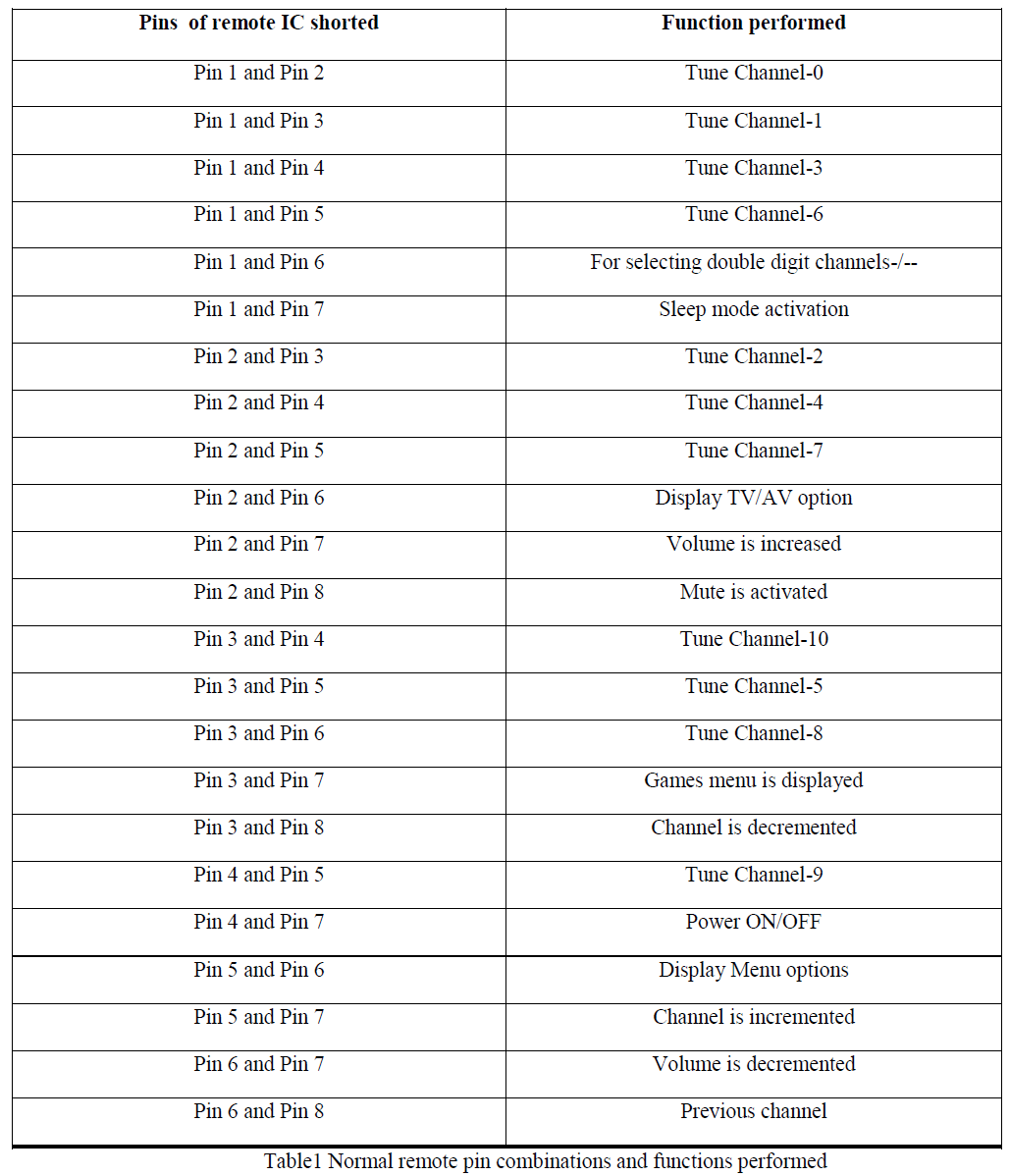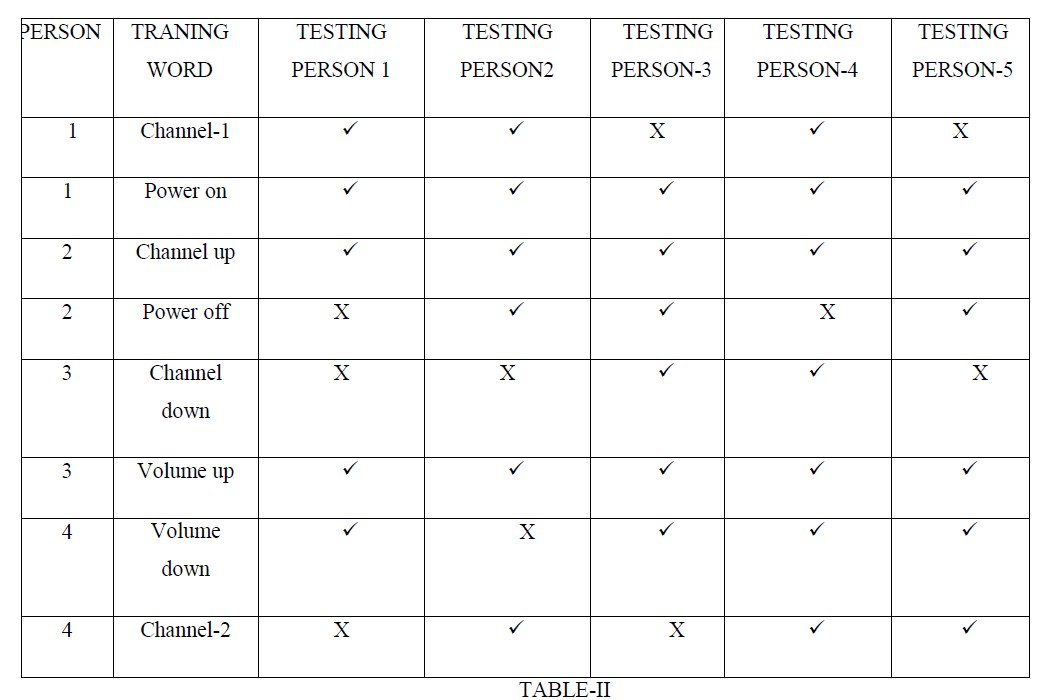ISSN ONLINE(2278-8875) PRINT (2320-3765)
ISSN ONLINE(2278-8875) PRINT (2320-3765)
Yakkanti Nagarjuna Reddy1, Tanuj Kumar Singh2, Shaik Mohammed Sajit3, Ajit Kumar Singh4, Dr.M.B.R.Murthy5
|
| Related article at Pubmed, Scholar Google |
Visit for more related articles at International Journal of Advanced Research in Electrical, Electronics and Instrumentation Engineering
There are various electronic goods, house hold appliances that are controlled with Micro Controllers the research in speech processing led to development of Speech recognition integrated circuits. This paper describes the development of a voice operated TV remote using the IC of conventional remote, a speech recognition IC and a Micro Controller. By speaking the channel of choice the TV receiver automatically tunes to that channel. The test results are presented and discussed.
Keywords |
| TV Remote control, Speech recognition, Micro controller. |
INTRODUCTION |
| The developments in electronics paved way for a number of instruments and gadgets of scientific, medicinal use and also for entertainment. One such item commonly found in every house in the present era is the Television receiver. The first practical demonstration of television was made by John Logie Baird. He showed a working television system to the public in 1925. In 1939 that RCA began the first commercial and public television broadcasts using Farnsworth's system. In the modern TV industry, there are six main types of televisions. They are: CRT – Cathode Ray Tube, RP – Rear Projection (Commonly called “big screen” TVs), DLP – Digital Light Projection, LCD – Liquid Crystal Display, PDP – Plasma Display Panel, LED – Light Emitting Diode |
| To turn on or off or to tune to any desired channel from a distance remote control unit is used and the remote controls have undergone several developments [1-5]. The first TV remote "Lazy Bone." was made by Zenith Radio Corporation in 1950. It was attached to the television by a bulky cable. Since then there were improvements and wireless units also are developed. With the advent of micro-processors and later microcontrollers many of data acquisition and control operations have been taken over by these. With a conventional TV remote in order to switch on or switch off TV set or change the channel from one to another or to change volume corresponding buttons are to be pressed. Undoubtedly it would be simple and convenient if these operations can be carried by simple voice commands like “on, off, “channel 2”, volume up etc. Further such a voice operated remote would be of immense help to old persons and sick people. This paper presents the development of a voice operated TV remote using IC of normal remote, Speech Recognition IC HM 2007 and ARM 7 micro-controller. |
II VOICE OPERATED REMOTE METHODOLOGY: |
| The schematic diagram of voice operated TV remote is shown in figure 1. |
 |
| The HM 2007 is basically a voice recognition IC and has self-contained stand alone speech recognition circuit which is user programmable [6][7]. This can store up to 20 words each of duration two seconds. The words can be multi-lingual. Inbuilt microphone is present. The circuit available in market has an external 64k SRAM connected directly to HM2007 and has a non-volatile memory with battery backup of 3V onboard. It supports two control modes namely manual mode and CPU mode. |
| A universal remote available in local market was tested and it was found that whenever a button on remote is pressed two pins of the IC in remote unit are shorted and for every such combination of two pins a specific function is performed by the remote. The test results are shown in table I. In the present scheme the shorting of appropriate pins is achieved by means of relays. Each relay is connected to two pins of the ordinary remote’s IC. |
 |
| The desired voice command like on/off/1/2/volume up etc is given to the system by the user through mike connected to HM2007.In the SRAM of HM 2007 a look up table is stored in which a unique pulse is assigned to every command. When the user gives the voice input, HM2007 searches the look up table and tries to match the given input with the stored values. When a match is found the corresponding pulse assigned to that command is generated. This pulse is transmitted through relay to IR transmitter of normal remote. The controller is programmed in such a way that it controls the relays to be activated according to the pulses that the controller receives from the voice IC. The relays which get activated short the proper pins of IC in remote and the pulses generated are transmitted through the IR transmitter to the IR receiver. The IR receiver in TV receives the pulses and necessary task is performed as usual. |
| In the present system initially 8 operations are considered. They are power on, power off, channel1, channel 2, volume up, volume down, next channel and previous channel. The system is trained by four persons each giving two commands as follows. Person-1 spoke Channel-1, Power on, Person-2 spoke Channel-up, power off; Person-3 spoke Channel-Down, Volume up and Person-4 spoke volume down, channel-2. |
RESULTS |
| The voice operated TV remote control has been built up and tested for several operations, namely ,volume up, volume down, channel-1, channel-2, next channel, previous channel, switch on and switch off. First it was tested by persons giving the same voice commands that were used during training for storage. The inputs and resulting actions are tabulated in the table II. The tick mark in the table shows that the input was accepted by the system and correct operation was performed. A cross mark shows that the voice IC was unable to recognize the input voice command given by the user. In case when a person gave same command as that used during training, the remote functioned properly. When they spoke commands of other persons used for storing still the response was correct more than half the time. Finally a person who did not train the system was asked to give all the commands and systems response was correct in 6 out of 8 commands. |
 |
IV. CONCLUSION |
| An ordinary TV remote is modified as voice operated remote. Test results are encouraging. This unit could be of immense help to old people and sick people who can operate the remote with ease. The proposed scheme can be extended to include all channels by increasing the relays. Further by expanding the memory of the HM 2007 and making necessary modifications in micro controller program the same remote can be used to operate DVD Player also in addition to TV. |
ACKNOWLEDGEMENTS |
| The authors wish to express their sincere thanks to Head of ECE department, Principal and management of CMR College of Engineering and Technology for providing the necessary facilities to carry out the work and their encouragement. |
References |
|